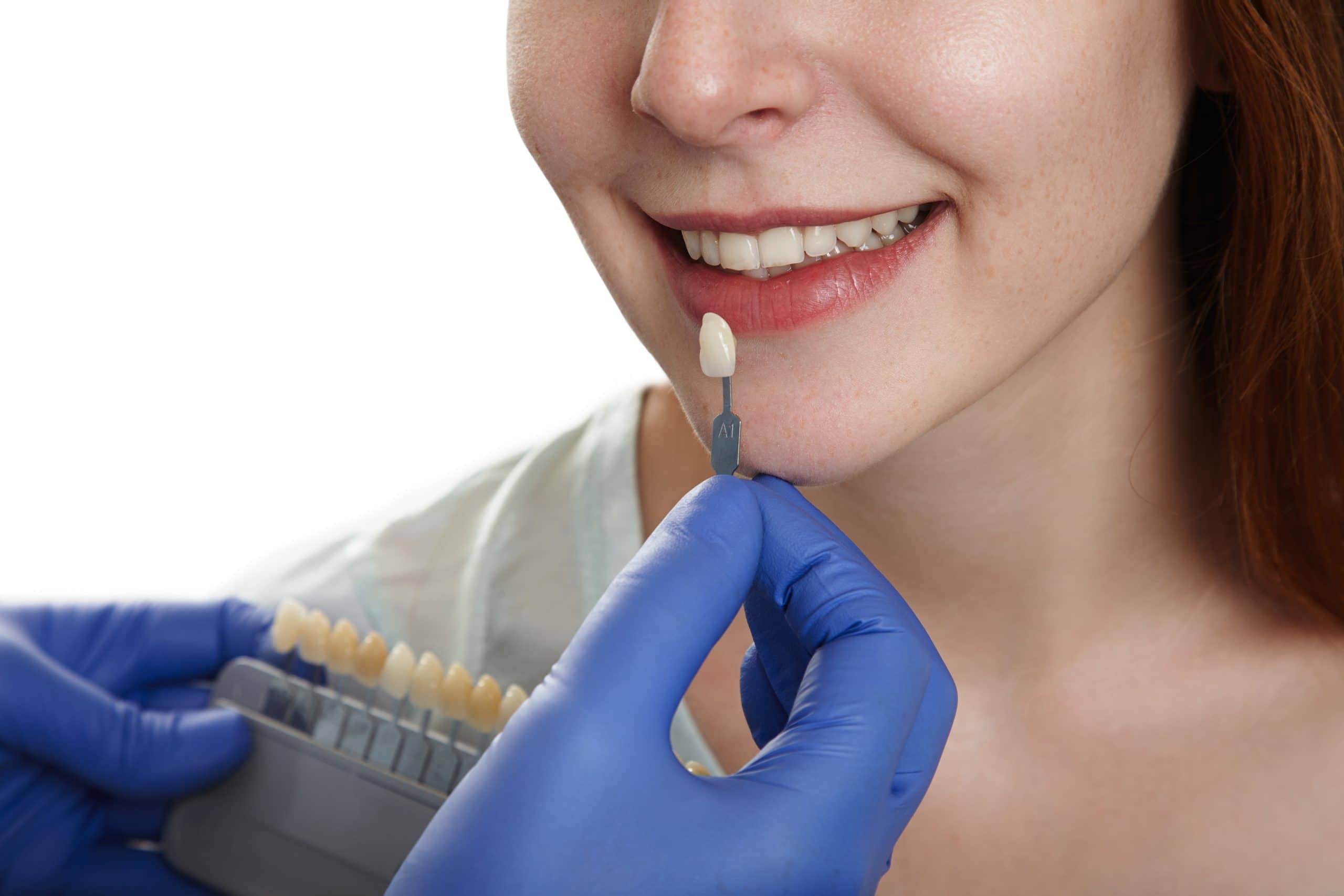
What Is a Digital Smile Design, and How Does It Transform Veneer Treatment?
By Dr. Bhumit Shah
“What is a Digital Smile Design?” It’s an advanced 3D technology that lets dentists preview your future smile digitally. Using high-resolution imaging and computer-guided design, your new smile is planned before any treatment begins. This helps patients better understand potential treatment outcomes before committing, supporting informed choices through visual previews. It’s helpful for those exploring veneers and wanting a more tailored treatment planning process.
Some people researching veneers want natural-looking results with fewer surprises. Digital Smile Design makes the process more accurate, collaborative, and visually guided. Patients can view proposed changes, discuss preferences, and feel confident about their options. This modern approach supports informed decisions and reflects the latest advancements in cosmetic dental care.
Contents
- 1 Summary of The Content
- 2 Understanding Digital Smile Design Technology in Cosmetic Dentistry
- 3 The Role of Digital Smile Design in Modern Veneer Application
- 4 The Digital Smile Design Process
- 5 Benefits of Digital Smile Design for Veneer Patients
- 6 Is Digital Smile Design Right for Your Veneer Treatment?
- 7 Final Thoughts
Summary of The Content
- Digital Smile Design is a digital planning tool used in cosmetic dentistry. It helps dentists design smiles with 3D imaging.
- Dentists use this technology to map facial features and teeth. It allows for accurate and personalised smile planning.
- The system helps improve planning by previewing possible outcomes. Patients can view their proposed smile before treatment begins.
- High-resolution scans capture detailed images of teeth, lips, and facial symmetry. These images help guide each custom smile design.
- Dentists create several design options for patients to review. Patients can ask questions and choose the option that fits their needs.
- Temporary veneers are made from the chosen design. Patients can try the smile before final veneers are crafted.
- Digital planning enhances lab communication and reduces adjustments. This approach may help reduce appointment times and the chance of additional adjustments.
- Outcomes vary based on individual needs. A consultation is essential to assess suitability for treatment.
Understanding Digital Smile Design Technology in Cosmetic Dentistry
“What is a Digital Smile Design?” It is a cosmetic dentistry approach that uses 3D imaging and specialised software for treatment planning. Dentists use this technology to design smiles with enhanced visual alignment, structural accuracy, and improved patient communication.
This approach improved treatment planning by aligning smile design with facial features and oral health, helping patients visualise potential results. It incorporates tools such as facial analysis, high-resolution scans, and specialised software to create personalised and functional smile designs. In this section, we explore how Digital Smile Design works, how it differs from traditional methods, and its benefits for patients.
Key Components of Digital Smile Design Technology
- High-Resolution 3D Imaging:
Dentists use intraoral scanners and facial photography to capture accurate 3D images of the teeth, gums, lips, and facial structure. This imaging allows for a detailed analysis of the patient’s smile from multiple angles. - Specialised Dental Software:
Dentists import digital images into specialised software to begin designing the proposed tooth shape, size, and position. The design aligns with each patient’s facial structure, bite, and aesthetic goals, supporting a personalised and informed treatment plan. - Computer-Aided Smile Simulation:
Dentists create digital mock-ups to demonstrate potential smile outcomes before any treatment starts, visually. This helps patients understand their options and select a treatment plan that aligns with their goals.
How Digital Smile Design Differs from Traditional Methods
- Visual Simulation vs. Imagination:
Traditional cosmetic dentistry often relied on basic 2D models or wax-ups that required patients to visualise results without much accuracy. DSD eliminates guesswork by providing a realistic preview. - Collaborative Planning vs. Passive Observation:
With DSD, patients actively participate in designing their smile, reviewing digital previews and giving feedback before any work starts. In contrast, older methods offered limited input opportunities for patients. - Digital Precision vs. Manual Estimations:
Traditional processes depended heavily on the clinician’s judgment for tooth proportion and alignment. DSD introduces measurable, data-driven design elements that align with aesthetics and functional anatomy.
How the Technology Works in Detail
- Capturing Smile Dynamics:
The dentist captures digital photos and videos to observe how your teeth, lips, and face move during natural expressions. This process helps assess facial dynamics such as smiling and speaking before planning any cosmetic dental treatment. - Facial and Dental Analysis:
The software maps facial landmarks, lip lines, and gum symmetry based on each patient’s unique dental and facial structure. It helps dentists design a proposed smile that complements the patient’s overall facial proportions and natural aesthetic balance. - Designing Multiple Smile Options:
Dentists can create several smile simulations based on different goals—such as a youthful look, a natural finish, or a bolder aesthetic. This flexibility allows personalised treatment planning. - Guiding Treatment with Precision:
Once the design is approved, the dentist uses the digital file to create temporary veneers and guide treatment planning. They also send this file to the dental laboratory to assist in fabricating the final veneers based on the specifications.
Clinical and Patient Benefits of Digital Smile Design
- Improved Dentist-Patient Communication:
The visual previews help patients clearly understand their treatment options, ask informed questions, and feel more confident in their decisions. - Enhanced Predictability of Outcomes:
Dentists use digital planning to design the smile in advance, aligning closely with the agreed treatment goals. This approach may help reduce unexpected changes and improve the accuracy of the final result. - Reduced Need for Adjustments:
Digital smile design improves accuracy, which may reduce the need for multiple trial fittings during the veneer planning process. This can save time and support a more streamlined treatment experience tailored to the patient’s individual needs. - Increased Treatment Confidence:
Patients can ‘test-drive’ their new smile using temporary restorations created from the digital plan, offering a realistic preview of the outcome. - Optimised Aesthetic Integration:
The system analyses facial symmetry, skin tone, and lip movement to assist with personalised veneer planning. This approach helps design veneers that complement individual features and contribute to a natural-looking smile.
Digital Smile Design transforms cosmetic dentistry by replacing subjective estimation with science-backed visual planning. Patients benefit from improved clarity, collaboration, and confidence—making the veneer journey more predictable and personalised.
The Role of Digital Smile Design in Modern Veneer Application
Traditional veneer planning relied on the dentist’s interpretation and the patient’s ability to visualise potential results. This approach often involved wax models and guesswork, making precise outcomes difficult to predict. Digital Smile Design allows patients to preview their proposed smile using high-resolution images and 3D simulations. This process may improve patient confidence by enabling informed decisions before any changes are made.
Digital planning supports consistency and alignment between stages of veneer treatment, from design to final placement. Dentists use the digital model to create temporary veneers for real-life testing before final fabrication. This reduces chair time, minimises adjustments, and enhances communication with dental laboratories. Digital Smile Design complements clinical skills by improving workflow efficiency, aesthetic precision, and overall treatment predictability.
The Digital Smile Design Process
The Digital Smile Design (DSD) process is a patient-centred approach that uses advanced digital technology to plan and preview cosmetic dental procedures. Here’s a step-by-step guide explaining how dental professionals use the technology to help patients achieve a confident, precise, and natural-looking smile.
- Initial Consultation with a Focus on Facial Symmetry:
During the initial consultation, the dentist captures high-resolution digital photographs and a digital impression using an intraoral scanner. They also record the patient’s facial features and existing teeth to assess facial symmetry and overall dental aesthetics. - Advanced Imaging and Digital Modelling:
The Digital Smile Design software processes this information to generate a digital model of the patient’s mouth. This model provides a visual representation of how treatments like porcelain veneers may influence the patient’s facial structures. It helps patients understand how cosmetic dental procedures, including dental implants, may change their smile before treatment begins. - Collaborative Smile Design for Patient Involvement:
The dentist uses the digital smile model to guide the patient through a collaborative smile design discussion. Patients review and discuss tailored options based on their facial features, tooth shape, and realistic expectations. - Trial Smile for Enhanced Patient Satisfaction:
With the help of specialised DSD software, temporary veneers based on the chosen design are created. Patients can preview their new smile during this trial phase, so they can feel confident before committing to irreversible changes. - Precise Fabrication of Final Veneers:
Once approved, the digital smile design guides the fabrication of the final result. Dental professionals use software algorithms and CAD/CAM systems to craft veneers with a precise and accurate fit. This technology helps create natural-looking veneers that integrate well with the patient’s existing teeth and facial features. - Integration of Aesthetic and Restorative Dentistry:
Digital Smile Design bridges cosmetic and restorative dentistry by aligning the patient’s aesthetic goals with functional requirements. It contributes to optimal results by considering the patient’s bite, oral health, and long-term dental function. - Personalised Treatment Plan Based on Thorough Knowledge:
Every treatment plan is developed based on individual assessments, which may include X-rays, dental photographs, and digital impressions. This supports clinicians in identifying good candidates for appropriate care through the DSD process. - Ongoing Technological Investment:
Modern dentistry continues to evolve, and dental professionals who offer Digital Smile Design often invest in the latest digital technology and training. This commitment enhances the collaborative process and contributes to achieving an aesthetically pleasing and functional outcome.
By using Digital Smile Design, dental clinics combine modern tools with clinical skills to improve patient satisfaction. However, outcomes depend on individual circumstances, and patients should always discuss suitability with a qualified dental professional during their smile makeover consultation.
Benefits of Digital Smile Design for Veneer Patients
Digital Smile Design (DSD) brings a range of benefits to patients considering veneers. Below are the key advantages patients can expect with this technology-enhanced approach.
Predictability Reduces Uncertainty
- Visual Preview of Final Results:
Patients can see a 3D simulation of their expected smile before treatment begins, helping them feel more confident about their treatment choices. - Improved Outcome Accuracy:
Digital planning guides veneer design to match the proposed plan. This may reduce the need for major changes at placement. - Lowered Anxiety During Treatment:
Seeing a visual preview can help patients feel more informed about what to expect during their veneer treatment.
Enhanced Dentist–Patient Communication
- Visual Aids Simplify Choices:
Dentists can show multiple smile design options, helping patients choose shapes, shades, and styles suited to their individual preferences and facial features. - Shared Decision-Making Encouraged:
DSD invites patients to actively participate in their smile planning, leading to satisfaction with the final result. - Improved Understanding of Treatment Scope:
Complex concepts such as bite alignment or gum line adjustments become easier to grasp with visual explanations.
Time Efficiency and Fewer Revisions
- Reduced Number of Appointments:
Digitally precise planning often means fewer visits are needed to adjust temporary veneers or remake restorations. - Streamlined Laboratory Workflow:
Dental labs receive exact digital specifications, which improves turnaround time and minimises errors. - Minimised Chair Time:
Because the design is finalised beforehand, placement appointments are typically shorter and more efficient.
Aesthetic Customisation
- Precise Colour Matching:
Digital tools assist in selecting shades that blend with surrounding teeth and facial features. - Symmetry and Proportions Analysed Scientifically:
Software analyses tooth dimensions, lip lines, and facial symmetry to create a balanced and natural-looking smile. - Facial Integration for Natural Results:
The design assesses how your smile looks at rest and in motion. This helps create a result that suits your facial features.
Functional Improvements Beyond Cosmetics
- Improved Bite Alignment:
In some cases, DSD-guided veneer planning may help address minor occlusal imbalances. However, functional concerns should be assessed thoroughly by your dentist. - Support for Long-Term Oral Health:
Proper alignment and contact points help with better oral hygiene and reduce the risk of food traps or gum irritation. - Preservation of Healthy Tooth Structure:
More accurate planning can reduce the need for excessive tooth reduction, preserving natural enamel when possible.
Financial and Practical Value
- Fewer Remakes Save Time and Cost:
A well-executed design reduces errors and material waste, which may lower the need for costly adjustments. - Efficient Workflow Reduces Downtime:
Patients often complete their treatment faster, which may be beneficial for those with time constraints. - Informed Investment Decisions:
When patients understand the process and see the likely outcome beforehand, they feel more confident in committing to the treatment.
Important Considerations for Individual Results
- Personal Oral Health Affects Outcomes:
Factors such as gum health, existing bite issues, or previous dental work influence the success of veneer treatment with DSD. - Realistic Expectations Are Essential:
While DSD offers significant advantages, it cannot deliver identical results for everyone, as outcomes depend on individual needs and anatomy. - Ongoing Maintenance Still Required:
Patients must maintain good oral hygiene and attend regular dental checkups to preserve results.
Digital Smile Design assists patients and clinicians in achieving clarity, efficiency, and precision during veneer treatment. DSD improves planning, communication, and outcomes, enabling a more informed and comfortable cosmetic dental experience. Every smile is unique, so dentists personalise treatment plans based on individual needs, oral health, and clinical assessment.
Is Digital Smile Design Right for Your Veneer Treatment?
Digital Smile Design can enhance veneer planning, offering precision and visual previews for patients with specific cosmetic or functional goals. However, its suitability depends on your dental needs and should be assessed during a personalised consultation with a qualified dentist. Below is an overview of when DSD may offer the most valuable benefits and when it might be less essential:
- Patients with Complex Aesthetic Goals:
Patients with detailed cosmetic concerns often benefit from Digital Smile Design due to its highly personalised planning capabilities. This technology helps design smiles that consider facial proportions, gum lines, and the position of multiple teeth. - Ideal for Those Who Want to Preview Their Results:
If you feel uncertain about committing to veneers without seeing the projected outcome, DSD offers a visual simulation of your potential smile. This preview can provide clarity and help you make confident decisions about your treatment. - Useful for Patients Seeking Collaborative Planning:
Some patients prefer to be actively involved in their treatment design. DSD facilitates collaborative communication between you and your dentist, allowing for shared input and a clearer understanding of your options before proceeding. - Important for Customised Smile Transformations:
If you have specific smile goals, Digital Smile Design allows for detailed planning tailored to your facial features. Traditional methods rely more on clinical judgement and may not offer the same level of visual precision or personalisation. - May Be Less Necessary for Simple, Single-Tooth Cases:
For isolated veneers or single-tooth improvements where aesthetic complexity is minimal, traditional planning methods may be sufficient and cost-effective. In these cases, DSD might not significantly enhance outcomes. - Requires a Dentist with Specific DSD Training:
Not all dentists are trained in Digital Smile Design. Successful results depend on a practitioner’s familiarity with DSD software, understanding of digital workflows, and hands-on experience with multiple DSD cases. - Ask About Equipment, Experience, and Case Volume:
Ask your provider about the digital equipment they use and the specific Digital Smile Design software in their practice. Also, ask how many Digital Smile Design cases they complete each year to understand their experience with the technology. These factors influence the precision and predictability of your outcome. - Technology Is Only as Effective as the Clinician Using It:
Even the most advanced design tools cannot replace clinical judgement. Optimal results come from combining digital accuracy with the dentist’s skill, training, and artistic understanding of smile aesthetics. - A Personal Consultation Is Essential:
Every patient’s dental condition is unique. A face-to-face consultation is necessary to assess whether Digital Smile Design will offer meaningful value for your veneer treatment goals. This information is general in nature and not a substitute for personalised dental advice.
Your decision to use Digital Smile Design depends on your treatment goals and how predictable you want the outcome to be. It also relies on your dentist’s experience with the technology and their ability to plan treatments using digital systems effectively. A personalised assessment by a qualified dentist is the most reliable way to determine its value in your specific case.
Final Thoughts
Digital Smile Design is transforming how veneers are planned, giving patients clearer insight into their potential smile results. “What is a Digital Smile Design?” It’s a modern tool that allows you to preview and refine your smile before any treatment. This helps reduce uncertainty and improves communication between you and your dentist. While the technology is advanced, a skilled clinician remains key to achieving naturally beautiful outcomes.
At Dentalcare of Forrestfield, we embrace leading dental innovations while prioritising personalised, compassionate care for every patient. We invite you to book a consultation to explore whether Digital Smile Design is right for your smile goals. Our team welcomes all questions and is committed to guiding you through each option with transparency. Please note: results vary for each individual, and a personal consultation is required for tailored clinical advice.



